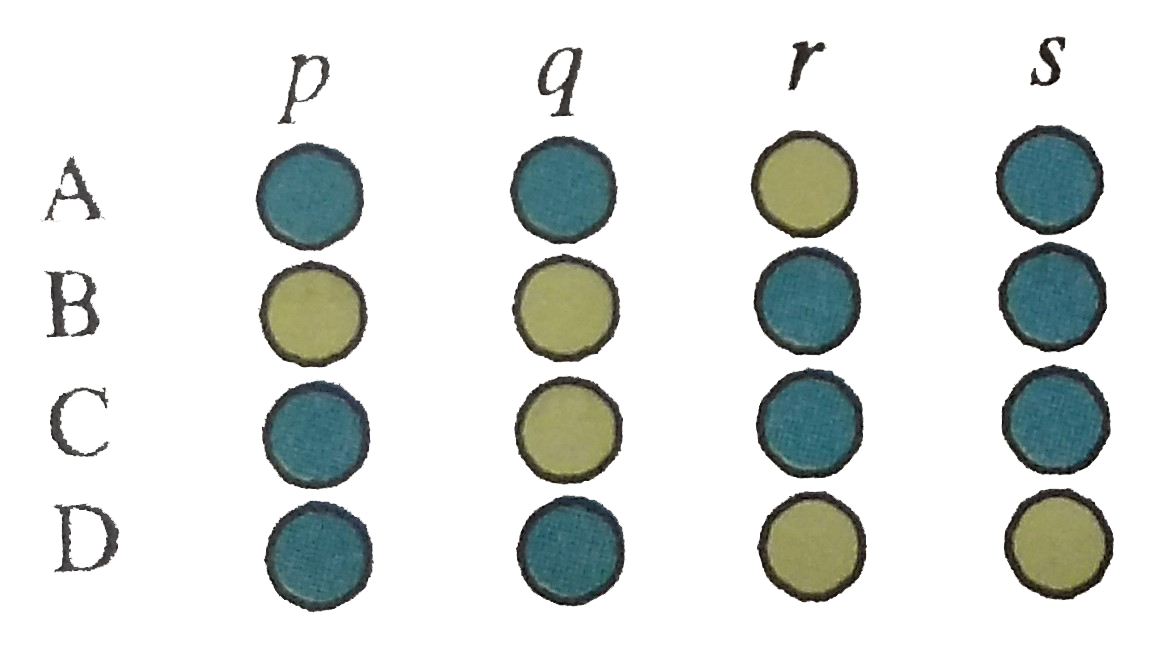Column−I(Ore)Column−II(A)Iron(p)Carbon reduction method(B)Lead(q)Self reduction(C)Copper(r)Thermite process(D)Chromium(s)Hydrometallurgical process
The correct Answer is:(A)→p;(B)→p,q;(C)→q,s;(D)→r
To solve the matching question regarding the ores and their extraction methods, we will analyze each ore listed in Column I and determine the appropriate extraction method from Column II.
1. Identify the Ore: Iron
- Iron is primarily extracted from its oxide ore, such as hematite (Fe2O3) or magnetite (Fe3O4).
- The common method for extracting iron is through the carbon reduction method. In this process, iron oxide reacts with carbon (usually in the form of coke) at high temperatures to produce molten iron and carbon monoxide.
- Match: A (Iron) → P (Carbon reduction method)
2. Identify the Ore: Lead
- Lead is extracted from its ore, galena (PbS), through a process that involves roasting to convert it to lead oxide (PbO), followed by reduction with carbon.
- This method is also classified under the carbon reduction method.
- Match: B (Lead) → P (Carbon reduction method)
3. Identify the Ore: Copper
- Copper is extracted from its sulfide ore, chalcopyrite (CuFeS2), through a process called roasting, which converts it to copper(I) oxide (Cu2O) and sulfur dioxide (SO2).
- The reduction of copper(I) oxide to copper metal can occur through a process known as self-reduction, where Cu2S acts as a reducing agent.
- Match: C (Copper) → Q (Self reduction)
4. Identify the Ore: Chromium
- Chromium is typically extracted from chromite ore (FeCr2O4) using the thermite process, which involves a reaction between chromium oxide and aluminum powder, producing chromium metal and aluminum oxide.
- Match: D (Chromium) → R (Thermite process)
Final Matches:
- A → P (Iron → Carbon reduction method)
- B → P (Lead → Carbon reduction method)
- C → Q (Copper → Self reduction)
- D → R (Chromium → Thermite process)
Summary of Matches:
- A (Iron) → P (Carbon reduction method)
- B (Lead) → P (Carbon reduction method)
- C (Copper) → Q (Self reduction)
- D (Chromium) → R (Thermite process)
- Iron is primarily extracted from its oxide ore, such as hematite (Fe2O3) or magnetite (Fe3O4).
- The common method for extracting iron is through the carbon reduction method. In this process, iron oxide reacts with carbon (usually in the form of coke) at high temperatures to produce molten iron and carbon monoxide.
- Match: A (Iron) → P (Carbon reduction method)
- Lead is extracted from its ore, galena (PbS), through a process that involves roasting to convert it to lead oxide (PbO), followed by reduction with carbon.
- This method is also classified under the carbon reduction method.
- Match: B (Lead) → P (Carbon reduction method)
- Copper is extracted from its sulfide ore, chalcopyrite (CuFeS2), through a process called roasting, which converts it to copper(I) oxide (Cu2O) and sulfur dioxide (SO2).
- The reduction of copper(I) oxide to copper metal can occur through a process known as self-reduction, where Cu2S acts as a reducing agent.
- Match: C (Copper) → Q (Self reduction)
- Chromium is typically extracted from chromite ore (FeCr2O4) using the thermite process, which involves a reaction between chromium oxide and aluminum powder, producing chromium metal and aluminum oxide.
- Match: D (Chromium) → R (Thermite process)
- A → P (Iron → Carbon reduction method)
- B → P (Lead → Carbon reduction method)
- C → Q (Copper → Self reduction)
- D → R (Chromium → Thermite process)
- A (Iron) → P (Carbon reduction method)
- B (Lead) → P (Carbon reduction method)
- C (Copper) → Q (Self reduction)
- D (Chromium) → R (Thermite process)
Topper's Solved these Questions
- METALLURGYBOOK - ALLENCHAPTER - METALLURGYEXERCISE - EXERCISE -04
54 Videos
- METALLURGYBOOK - ALLENCHAPTER - METALLURGYEXERCISE - EXERCISE-05 [A]
11 Videos
- METALLURGYBOOK - ALLENCHAPTER - METALLURGYEXERCISE - EXERCISE-02
45 Videos
- ISOMERISM BOOK - ALLENCHAPTER - ISOMERISM EXERCISE - MCQ
20 Videos
- MOLE CONCEPTBOOK - ALLENCHAPTER - MOLE CONCEPTEXERCISE - J-ADVANCE
2 Videos
Similar Questions
Column−I(Metal)column−II(A)Magnesite(p)Ore of magnesium(B)Siderite(q)Ore of aluminium(C)Corundum(r)Oxide ore(D)Bauxite(s)Carbonate ore
Match
View SolutionMatch the column I with column II
Column-IColumn-II(A)Starch(p)Natural polymer(B)Nylon-6(q)Synthetic polymer(C)Peptide Bond(r)Amide linkage(D)Maltose(s)Glycoside linkage(t)Oligosaccharide
View Solution
Knowledge Check
Match the Column I with Column II and mark the approprite choice.
Column IColumn II(A)Galena(i)Abrasive(B)Diamond(ii)Metal carbonyls(C)Carbon monoxide(iii)Hydrides of Si(D)Silanes(iv)An ore of leadA(A) → (iv), (B) → (ii), (C ) → (i), (D) → (iii)B(A) → (iv), (B) → (i), (C ) → (ii), (D) → (iii)C(A) → (ii), (B) → (i), (C ) → (iii), (D) → (iv)D(A) → (i), (B) → (ii), (C ) → (iii), (D) → (iv)
Match the column I with column II
Column-IColumn-II(A)Fructose(p)Protein(B)Zwitterion(q)Inversion(C)Peptide linkage(r)α−Amino acid(D)Hydrlysis of cane sugar(s)Carbohydroate(t)Ketose
View SolutionMatch the column I with column II
Column-IColumn-II(A)Natural rubber(p)Thermosetting polymer(B)Nylon-66(q)Homopolymer(C)Bakelite(r)Butadiene & styrene(D)Buna-S(s)Polyamide(t)Copolymer
View SolutionMatch the following
Column-IColumn-II(A)Enthalpy(p)Extensive property(B)Entropy(q)H - TS(C)Free energy(r)E + PV(D)Pressure(s)Intensive property
View SolutionMatch the extraction processes listed in Column I with metals listed in Column II.
Column IColumn II(A)Self reduction(p)Lead(B)Carbon reduction(q)Silver(C)Complex formation and displacement by metal(r)Copper(D)Decomposition of iodide(s)Boron
View SolutionMatch the following
Column-IColumn-II(A)Isothermal process(p)Temperature changes(B)Isobaric process(q)Pressure changes(C)Isochoric process(r)Volume change(D)Cyclic process(s)Initial and final states are same
View SolutionColumn IColumn II(A)R/L(p)Time(B)C/R(q)Frequency(C)E/B(r)Speed(D)√ε0μ0(s)None
View SolutionMatch the statements (A,B, C, D) in Column I with statements (p, q, r, s) in Column II The answer to the question have to be property bubbled
Column IColumn II(A)Ice(p) Tetrahedral(B)Nitre(q) Hydrogen bonded(C)Diamond(r) High melting(D)Ammonia(s) Crystalline solid

View Solution
